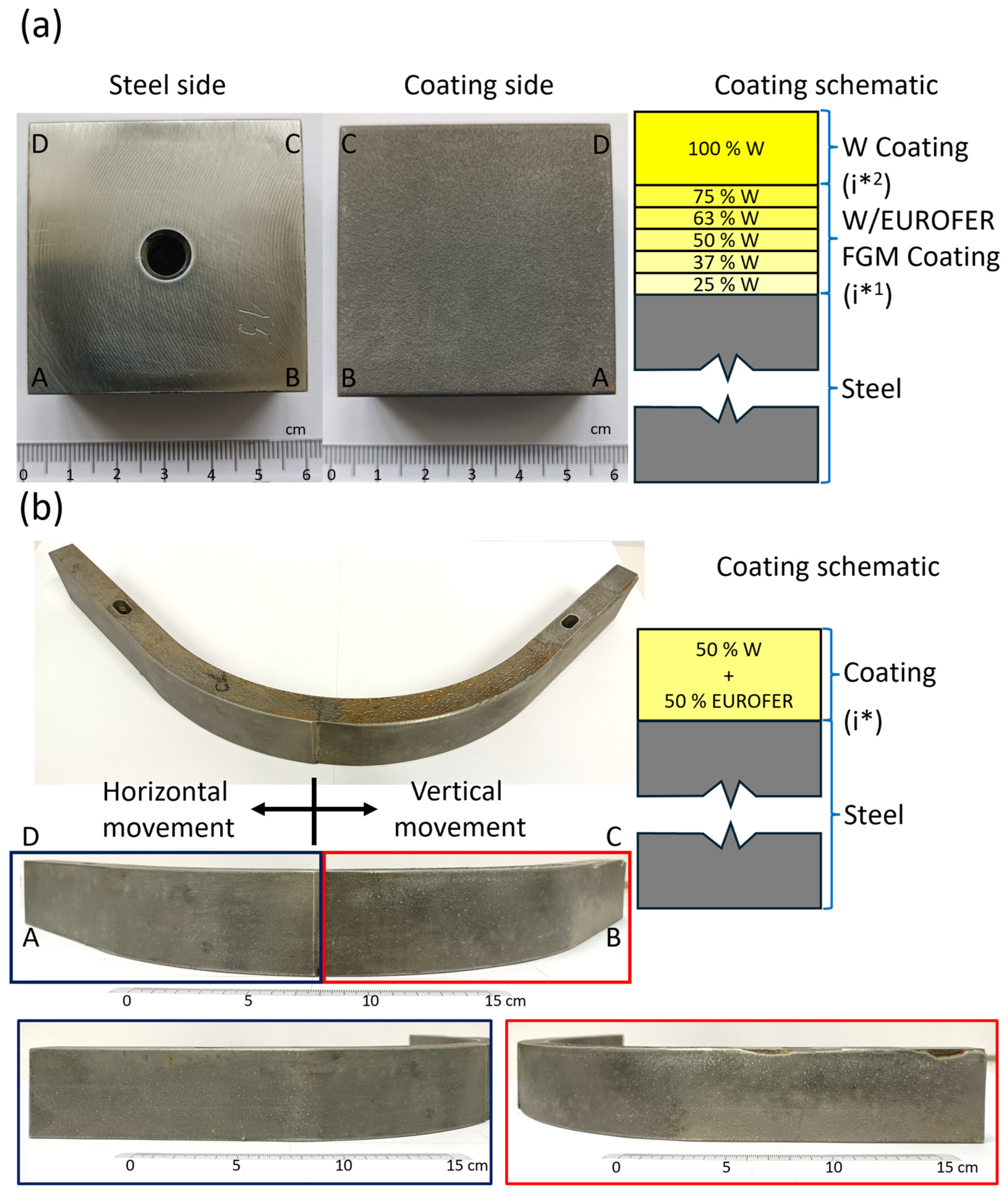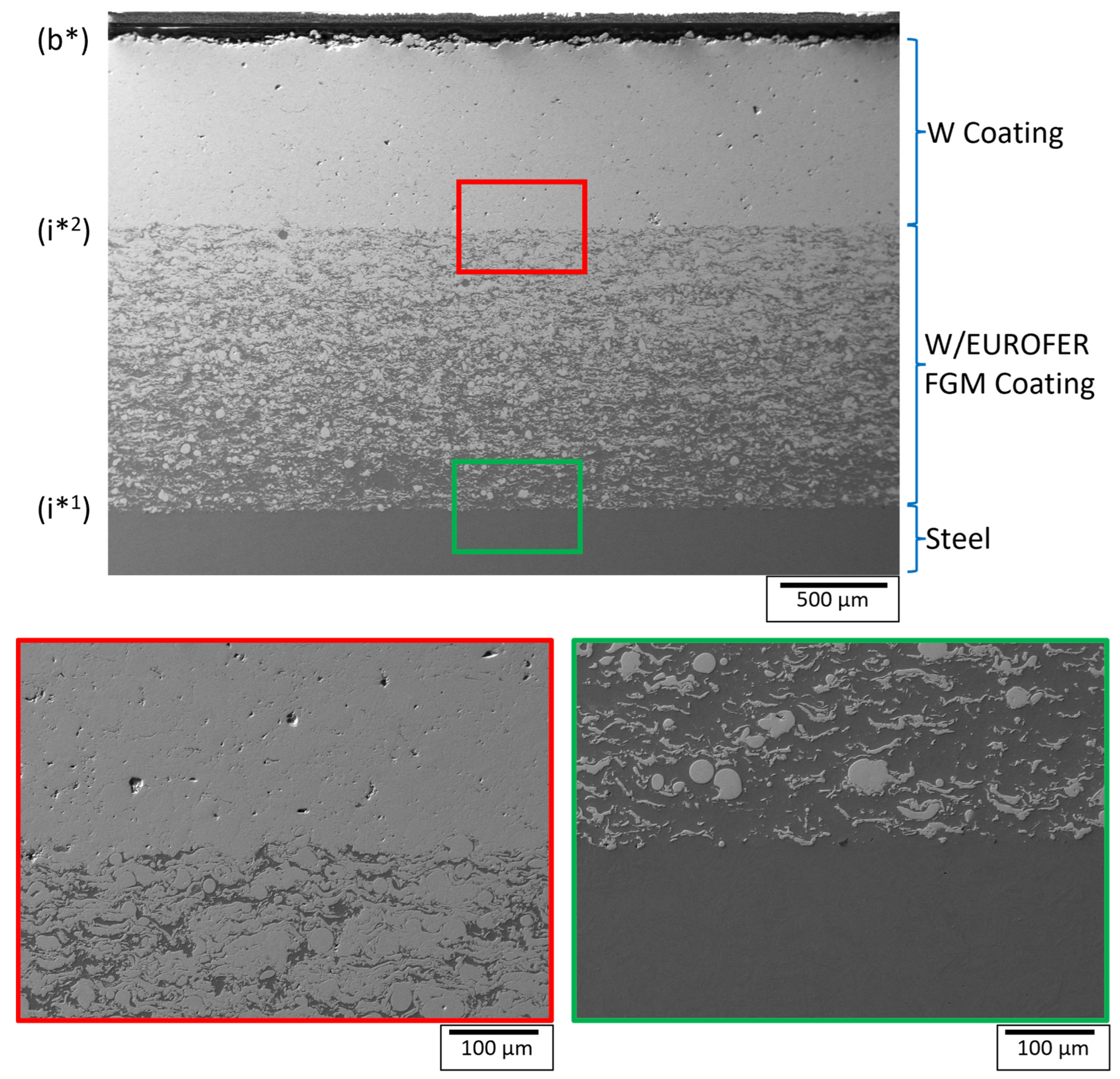Phased Array Ultrasonic Testing of W/EUROFER Functionally Graded Coating
Abstract
1. Introduction
2. Materials and Methods
2.1. Materials
2.2. Phased Array Ultrasonic Testing
3. Results and Discussion
4. Conclusions
- A detailed analysis was provided for the ultrasonic echo in W/EUROFER FGM coating over a steel substrate using the A-scan, B-scan, and C-scan. Distinguishable echoes were obtained from two different interfaces and the backwall in the coating, which were used to create a C-scan for the interfaces and backwall. No delamination was detected at any interface in the coated sample.
- The reliability of the phased array ultrasonic test was confirmed by image analysis of the cross-section.
- A C-scan was obtained for the interface and backwall in testing the L-shape 50% W and 50% EUROFER curve coated sample. The C-scan detected the position of the delaminated area, and a good correlation was achieved between the C-scan of the interface and the backwall. The accuracy of the phased array ultrasonic test in detecting delamination was confirmed by cross-sectional image analysis of the coating/substrate interface.
- A successful testing of an L-shape 50% W and 50% EUROFER curve coated sample shows that the phased array ultrasonic testing method is a reliable NDT method for detecting delamination in large-scale coated components for future fusion applications.
Author Contributions
Funding
Institutional Review Board Statement
Informed Consent Statement
Data Availability Statement
Acknowledgments
Conflicts of Interest
Abbreviations
| FGM | Functionally graded material |
| ITER | International Thermonuclear Experimental Reactor |
| DEMO | DEMOnstration |
| RF-ICP | Radio frequency inductively coupled plasma |
| PVD | Physical vapour deposition |
| CVD | Chemical vapour deposition |
| NDT | Non-destructive testing |
| TGO | Thermally grown oxides |
| SNR | Signal-to-noise ratio |
| PAUT | Phased array ultrasonic testing |
| LPPS | Low-pressure plasma spraying |
| EDM | Electrical discharge machining |
| VPS | Vacuum plasma spray |
References
- Luo, C.; Xu, L.; Zong, L.; Shen, H.; Wei, S. Research Status of Tungsten-Based Plasma-Facing Materials: A Review. Fusion Eng. Des. 2023, 190, 113487. [Google Scholar] [CrossRef]
- Heuer, S.; Matějíček, J.; Vilémová, M.; Koller, M.; Illkova, K.; Veverka, J.; Weber, T.; Pintsuk, G.; Coenen, J.W.; Linsmeier, C. Atmospheric Plasma Spraying of Functionally Graded Steel/Tungsten Layers for the First Wall of Future Fusion Reactors. Surf. Coat. Technol. 2019, 366, 170–178. [Google Scholar] [CrossRef]
- Matějíček, J.; Vilémová, M.; Nevrlá, B.; Kocmanová, L.; Veverka, J.; Halasová, M.; Hadraba, H. The Influence of Substrate Temperature and Spraying Distance on the Properties of Plasma Sprayed Tungsten and Steel Coatings Deposited in a Shrouding Chamber. Surf. Coat. Technol. 2017, 318, 217–223. [Google Scholar] [CrossRef]
- Mauer, G.; Rauwald, K.-H.; Sohn, Y.J. Tungsten-Steel Functionally Graded Coatings for Nuclear Fusion Applications Manufactured by Cold Gas Spraying. J. Therm. Spray Technol. 2023, 32, 375–387. [Google Scholar] [CrossRef]
- Neu, R.; Maier, H.; Böswirth, B.; Elgeti, S.; Greuner, H.; Hunger, K.; Kondas, J.; von Müller, A. Investigations on Cold Spray Tungsten/Tantalum Coatings for Plasma Facing Applications. Nucl. Mater. Energy 2023, 34, 101343. [Google Scholar] [CrossRef]
- Vaßen, R.; Rauwald, K.-H.; Guillon, O.; Aktaa, J.; Weber, T.; Back, H.C.; Qu, D.; Gibmeier, J. Vacuum Plasma Spraying of Functionally Graded Tungsten/EUROFER97 Coatings for Fusion Applications. Fusion Eng. Des. 2018, 133, 148–156. [Google Scholar] [CrossRef]
- Qu, D.D.; Basuki, W.W.; Gibmeier, J.; Vaßen, R.; Aktaa, J. Development of Functionally Graded Tungsten/EUROFER Coating System for First Wall Application. Fusion Sci. Technol. 2015, 68, 578–581. [Google Scholar] [CrossRef]
- Emmerich, T.; Qu, D.; Ghidersa, B.-E.; Lux, M.; Rey, J.; Vaßen, R.; Aktaa, J. Development Progress of Coating First Wall Components with Functionally Graded W/EUROFER Layers on Laboratory Scale. Nucl. Fusion 2020, 60, 126004. [Google Scholar] [CrossRef]
- Grammes, T.; Emmerich, T.; Aktaa, J. W/EUROFER Functionally Graded Coatings for Plasma Facing Components: Technology Transfer to Industry and Upscaling. Fusion Eng. Des. 2021, 173, 112940. [Google Scholar] [CrossRef]
- Wu, X.; Kondo, S.; Yu, H.; Nagasaka, T.; Kasada, R. Mechanical Properties of the W Coating and Interface of Vacuum-Plasma-Sprayed W–Ferritic Steel Joints under Shear and Bending Loads. Surf. Coat. Technol. 2023, 462, 129468. [Google Scholar] [CrossRef]
- Pakhomova, E.; Palombi, A.; Varone, A. Plasma Spraying of W Coatings for Nuclear Fusion Applications: Advancements and Challenges. Crystals 2025, 15, 408. [Google Scholar] [CrossRef]
- Kim, H.S.; Hong, B.G.; Moon, S.Y. Thick Tungsten Layer Coating on Ferritic-Martensitic Steel without Interlayer Using a DC Vacuum Plasma Spray and a RF Low Pressure Plasma Spray Method. Thin Solid Films 2017, 623, 59–64. [Google Scholar] [CrossRef]
- Klecka, J.; Cizek, J.; Matejicek, J.; Lukac, F.; Vala, J. Thick Functionally-Graded W-316L Composite Coatings for Nuclear Fusion Applications. Nucl. Mater. Energy 2023, 34, 101373. [Google Scholar] [CrossRef]
- Lee, J.; Shin, Y.C. Crack-Free Tungsten Coating on ODS Plate via a Modified Laser-Based Additive Technique: Offset Laser Cladding. Surf. Coat. Technol. 2024, 476, 130285. [Google Scholar] [CrossRef]
- Matějíček, J.; Nevrlá, B.; Vilémová, M.; Boldyryeva, H. Overview of Processing Technologies for Tungsten-Steel Composites and FGMs for Fusion Applications. Nukleonika 2015, 60, 267–273. [Google Scholar] [CrossRef]
- Maier, H.; Luthin, J.; Balden, M.; Linke, J.; Koch, F.; Bolt, H. Properties of Tungsten Coatings Deposited onto Fine Grain Graphite by Different Methods. Surf. Coat. Technol. 2001, 142–144, 733–737. [Google Scholar] [CrossRef]
- Kim, H.; Lee, H.J.; Kim, S.H.; Jang, C. Plasma Thermal Performance of a Dual-Process PVD/PS Tungsten Coating on Carbon-Based Panels for Nuclear Fusion Application. Fusion Eng. Des. 2016, 109–111, 590–595. [Google Scholar] [CrossRef]
- Matějíček, J.; Dejarnac, R.; Ruset, C.; Grigore, E.; Cvrček, L.; Walter, J.; Perry, F. Development of Tungsten Coatings on Inconel Superalloy for COMPASS Upgrade Plasma-Facing Components. Nucl. Mater. Energy 2025, 42, 101844. [Google Scholar] [CrossRef]
- Kim, H.; Lee, H.J.; Jang, C. Thermal Performance of Multilayer PVD Tungsten Coating for the First Wall Application in Nuclear Fusion Devices. Fusion Sci. Technol. 2015, 68, 378–382. [Google Scholar] [CrossRef]
- Chen, Z.; Lian, Y.-Y.; Liu, X.; Feng, F.; Yan, B.-Y.; Wang, J.-B.; Lv, Y.-W.; Song, J.-P.; Liu, C.-J.; Cai, L.-Z. Recent Research and Development of Thick CVD Tungsten Coatings for Fusion Application. Tungsten 2020, 2, 83–93. [Google Scholar] [CrossRef]
- Lian, Y.; Liu, X.; Cheng, Z.; Wang, J.; Song, J.; Yu, Y.; Chen, J. Thermal Shock Performance of CVD Tungsten Coating at Elevated Temperatures. J. Nucl. Mater. 2014, 455, 371–375. [Google Scholar] [CrossRef]
- Song, J.; Yu, Y.; Zhuang, Z.; Lian, Y.; Liu, X.; Qi, Y. Preparation of W–Cu Functionally Graded Material Coated with CVD–W for Plasma-Facing Components. J. Nucl. Mater. 2013, 442, S208–S213. [Google Scholar] [CrossRef]
- Lian, Y.; Liu, X.; Xu, Z.; Song, J.; Yu, Y. Preparation and Properties of CVD-W Coated W/Cu FGM Mock-Ups. Fusion Eng. Des. 2013, 88, 1694–1698. [Google Scholar] [CrossRef]
- Ang, A.S.M.; Berndt, C.C. A Review of Testing Methods for Thermal Spray Coatings. Int. Mater. Rev. 2014, 59, 179–223. [Google Scholar] [CrossRef]
- Jaya, B.N.; Mathews, N.G.; Mishra, A.K.; Basu, S.; Jacob, K. Non-Conventional Small-Scale Mechanical Testing of Materials. J. Indian Inst. Sci. 2022, 102, 139–171. [Google Scholar] [CrossRef]
- Lian, D.; Suga, Y.; Shou, G.; Kurihara, S. An Ultrasonic Testing Method for Detecting Delamination of Sprayed Ceramic Coating. J. Therm. Spray Technol. 1996, 5, 128–133. [Google Scholar] [CrossRef]
- Lescribaa, D.; Vincent, A. Ultrasonic Characterization of Plasma-Sprayed Coatings. Surf. Coat. Technol. 1996, 81, 297–306. [Google Scholar] [CrossRef]
- Mesrati, N.; Saif, Q.; Treheux, D.; Moughil, A.; Fantozzi, G.; Vincent, A. Characterization of Thermal Fatigue Damage of Thermal Barrier Produced by Atmospheric Plasma Spraying. Surf. Coat. Technol. 2004, 187, 185–193. [Google Scholar] [CrossRef]
- Kishore, M.B.; Lee, H.-G.; Abera, A.G.; Kim, H.J.; Seok, C.S.; Song, S.J. Quantitative Evaluation of Partial Delamination in Thermal Barrier Coatings Using Ultrasonic C-Scan Imaging. Int. J. Precis. Eng. Manuf. 2020, 21, 157–165. [Google Scholar] [CrossRef]
- Chen, H.-L.R.; Zhang, B.; Alvin, M.A.; Lin, Y. Ultrasonic Detection of Delamination and Material Characterization of Thermal Barrier Coatings. J. Therm. Spray Technol. 2012, 21, 1184–1194. [Google Scholar] [CrossRef]
- Rachidi, R.; Elkihel, B.; Delaunois, F.; Deschuyteneer, D. Effectiveness of Phased Array Focused Ultrasound and Active Infrared Thermography Methods as a Nondestructive Testing of Ni-WC Coating Adhesion. Nondestruct. Test. Eval. 2019, 34, 205–220. [Google Scholar] [CrossRef]
- Schroeder, J.A.; Ahmed, T.; Chaudhry, B.; Shepard, S. Non-Destructive Testing of Structural Composites and Adhesively Bonded Composite Joints: Pulsed Thermography. Compos. Part A Appl. Sci. Manuf. 2002, 33, 1511–1517. [Google Scholar] [CrossRef]
- Santangelo, P.E.; Allesina, G.; Bolelli, G.; Lusvarghi, L.; Matikainen, V.; Vuoristo, P. Infrared Thermography as a Non-Destructive Testing Solution for Thermal Spray Metal Coatings. J. Therm. Spray Technol. 2017, 26, 1982–1993. [Google Scholar] [CrossRef]
- Taheri, H.; Hassen, A.A. Nondestructive Ultrasonic Inspection of Composite Materials: A Comparative Advantage of Phased Array Ultrasonic. Appl. Sci. 2019, 9, 1628. [Google Scholar] [CrossRef]
- Grammes, T.; Emmerich, T.; Qu, D.; Heinze, O.; Vaßen, R.; Aktaa, J. Functionally Graded Tungsten/EUROFER Coating for DEMO First Wall: From Laboratory to Industrial Production. Fusion Eng. Des. 2023, 188, 113430. [Google Scholar] [CrossRef]
- Kim, B.J.; Kim, H.J.; Lim, B.S. Creep-Fatigue Damage and Life Prediction in P92 Alloy by Focused Ultrasound Measurements. Met. Mater. Int. 2008, 14, 391–395. [Google Scholar] [CrossRef]
- Shastri, S.K.; Rudresh, S.; Anand, R.; Nagesh, S.; Seelamantula, C.S.; Thittai, A.K. Axial Super-Resolution in Ultrasound Imaging with Application to Non-Destructive Evaluation. Ultrasonics 2020, 108, 106183. [Google Scholar] [CrossRef]







Disclaimer/Publisher’s Note: The statements, opinions and data contained in all publications are solely those of the individual author(s) and contributor(s) and not of MDPI and/or the editor(s). MDPI and/or the editor(s) disclaim responsibility for any injury to people or property resulting from any ideas, methods, instructions or products referred to in the content. |
© 2025 by the authors. Licensee MDPI, Basel, Switzerland. This article is an open access article distributed under the terms and conditions of the Creative Commons Attribution (CC BY) license (https://creativecommons.org/licenses/by/4.0/).
Share and Cite
Mishra, A.K.; Aktaa, J. Phased Array Ultrasonic Testing of W/EUROFER Functionally Graded Coating. Materials 2025, 18, 4896. https://doi.org/10.3390/ma18214896
Mishra AK, Aktaa J. Phased Array Ultrasonic Testing of W/EUROFER Functionally Graded Coating. Materials. 2025; 18(21):4896. https://doi.org/10.3390/ma18214896
Chicago/Turabian StyleMishra, Ashwini Kumar, and Jarir Aktaa. 2025. "Phased Array Ultrasonic Testing of W/EUROFER Functionally Graded Coating" Materials 18, no. 21: 4896. https://doi.org/10.3390/ma18214896
APA StyleMishra, A. K., & Aktaa, J. (2025). Phased Array Ultrasonic Testing of W/EUROFER Functionally Graded Coating. Materials, 18(21), 4896. https://doi.org/10.3390/ma18214896





